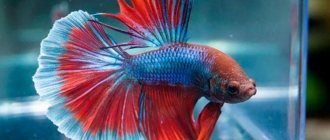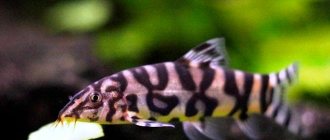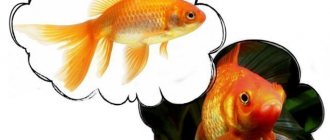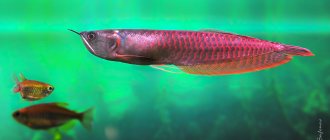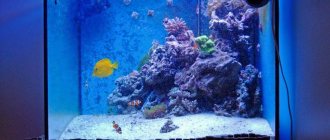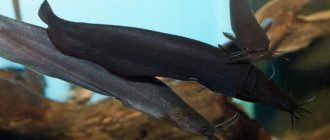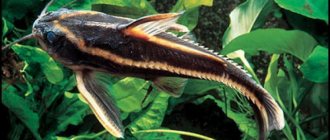One of the most common questions that aquarium fish lovers have is: “Do fish sleep??»
For us humans, sleep is synonymous with warmth and comfort, and we all want to crawl into a big, comfortable bed at the end of a long day.
This naturally raises the question of whether fish sleep at all, given that they are constantly suspended in cool water, trying to stay afloat.
We'll look at a number of frequently asked questions and the truth about when and how fish go to sleep.
Do all fish sleep the same?
Sleep in general, as a phenomenon, is a state that is characterized in mammals by a decrease in brain activity and the severity of reaction to the surrounding reality.
But fish are not mammals; their habitat is unlike the life of most living creatures, and their physical functionality is different. Accordingly, sleep in fish proceeds differently .
In addition, fish with different daily activity will rest at different times. So, catfish are active in the dark:
- looking for food;
- mate;
- move through a body of water.
During the daytime, they hide in secluded places. But fish with a daily activity cycle climb into shelters at night .
Breathe to live
Sharks, like all fish, need oxygen, which they get from water passed through their gills.
The respiratory organs of a shark are gill sacs, with internal openings going into the pharynx, and external openings onto the surface of the body (on the sides of the head). Biologists count from 5 to 7 pairs of gill slits in different species, located in front of the pectoral fins. When breathing, blood and water move in countercurrent
To prevent breathing from stopping, the shark must continuously move with its mouth open. Now it’s clear why sharks placed in a small pool flap their mouths slightly open: they lack movement, and therefore oxygen.
Fish dream - what is it anyway?
In human understanding, fish sleep is closer to light slumber. Judge for yourself:
- They do not completely lose control of the external situation. The fish is always ready to hide from danger.
- The brain activity of a sleeping fish does not change.
- Due to the physiological characteristics of a sleeping fish, its appearance remains the same (the eyes do not close, the movements of the tail do not stop).
You can distinguish a sleeping fish by the position of its body in the water column - it will be practically motionless , hovering in one place.
Some aquarium inhabitants prefer to cling to decorative elements or plant leaves, others like to hide in the shadows or swim into grottoes. But in any case, the fish will be practically motionless.
Winter and summer hibernation
Some inhabitants of the aquarium fall into suspended animation with the onset of cold weather . Of course, in the full sense, this is not a dream either, but the activity of the fish will be reduced. She will hide in a shelter and spend almost all her time there.
Interesting! There are varieties of fish that go into suspended animation with the onset of summer heat. In this way, the fish’s body is protected from dehydration.
Night and daytime sleep in fish
If in the dark the absence of eyelids does not in any way prevent the fish from enjoying its rest, then in daylight it has to look for shelter. During the day, the inhabitants of the aquarium choose shaded areas to relax:
- hiding in the thick of plants;
- swim into decorative buildings and grottoes;
- hiding in the shadow of stones.
Hibernation
On the eve of cold weather, certain phenotypes fall into a kind of hibernation, which differs from standard sleep. Just like when a fish goes to sleep, its basic functions slow down. During this period, the phenotypes move to the substrate, shady plants.
Certain species hibernate during the summer. They perform such actions in order to prevent the possibility of dehydration. After all, in the summer the temperature rises significantly.
How different fish sleep
It would be naive to think that if the subspecies inhabitants are so different from each other, then their dreams are the same. Nothing like this!
Bone
A striking representative of bony fish is the shark. She does not have an air sac, which is why she is unable to freeze in the water column.
But she adapted! The shark's spinal cord is responsible for movement .
Cartilaginous
Most often, they either “hang” in the water column or hide in shelter. Some individuals prefer to “stick” to a stone or decorative element.
Is it worth taking into account the sleeping habits of fish?
Some aquarists are studying this issue to gain more information. After all, whether experienced aquarists will be able to create appropriate conditions for the phenotypes of fish and shellfish depends on how extensive the knowledge base is.
In order for the phenotypes to develop and reproduce well, aquarists take into account certain rules:
- The selection of the tank is carried out with special care. Before purchasing, the appropriate volume, shape and configuration are determined.
- Determining suitable decorative elements and accessories. Some phenotypes require driftwood, tunnels, bridges and other details. For other individuals, more free space is needed so that they can move freely.
- Shady plants and algae are planted in the tank. Such bushes are used by small fish as shelter.
- Periodically, aquarists clean the substrate from organic residues and excrement. After all, they have a detrimental effect on the condition of labyrinthine and other species. Compressors and filters are used for this.
- When selecting phenotypes, features should be taken into account. It is advisable to choose fish that are resting and awake at the same time. If you do not follow this rule, then over time you will encounter diseases and deterioration of your condition.
- When selecting lighting equipment, the volume of the container is taken into account. To complete the equipment, fluorescent lamps of the required power level are used.
- At night, the lighting equipment is turned off in order to ensure optimal conditions.
Fish have a lot of anatomical features. They rest, but their sleep is different from ours. During sleep, the physical activity of the subspecies decreases. The metabolic process also slows down. All these features are remembered by both experienced and novice aquarists who care about the phenotypes of fish and shellfish.
Video about sleeping fish - botia and crucian carp
AdminAuthor of the article
Did you like the article?
Share with your friends:
Sleepless night hunters
Catfish and burbot prefer daytime rest. The period of their activity occurs during the dark time of the day. Therefore, experienced fishermen catch them at night.
Depending on how the inhabitants of the aquarium prefer to relax, it is necessary to shape the interior of the reservoir, select appropriate neighbors and plant certain plants .
To create comfortable living conditions, it is very important to take into account physiological characteristics such as sleep and activity time of your pets.
swim bladder
swim bladder
The swim bladder is the main “device” that allows fish to swim. But! It is present only in bony fish. Therefore, we first consider how bony fish exploit this organ, and then we are interested in how cartilaginous fish move in the water space.
So, the swim bladder is two different-sized, hollow “sausages” separated by a bridge. They are outgrowths of the esophagus. In the process of evolution, they were transformed into lungs, characteristic of more developed - amniotes, classes of terrestrial animals.
How does the swim bladder work?
Thanks to the presence of a swim bladder, the fish is kept at the depth it needs. The mechanism of operation of the organ is very simple. Remember Archimedes' law. The swim bladder is filled with air. Dropping below the level at which the mass of the fish coincides with the volume of water it displaces, the body of the animal undergoes compression. Naturally, at this moment the swim bladder is also compressed, from which air is displaced. This reduces the volume of water displaced by fish. The balance between the weight of the fish and the volume of displaced fluid is disrupted, allowing the animal to sink even lower.
If the fish floats to the surface, then approaching the surface of the water increases the amount of gases absorbed by the animal. Some of them enter the swim bladder, expanding it. The bubble “expands” the animal’s body, increasing the volume of displaced water. As a result of this action, the specific gravity of the fish decreases, and it itself is literally pushed to the surface.
In total, the swim bladder provides the fish with immersion, ascent and zero buoyancy in the mode of minimal energy consumption.
Why did they fall down, lie on their belly or on their side?
If the fish are lying on the bottom, then it is possible that the volume of the aquarium is too small for them. Very often, novice aquarists give their preference to newfangled aquariums, without thinking about how the fish will feel. This situation can lead to poor health in the pet.
Also, the reasons for this behavior may be the following circumstances:
- Overeating may be the reason that your pet suddenly finds itself at the bottom. The fish sinks down due to its heavy belly.
- If you notice that the fish are at the bottom at night, this means that they are simply resting.
All living creatures need rest, so most phenotypes sleep at night and are awake during the day. - If the fish were recently put into a new tank, but they lay to the bottom, then the reason is adaptation.
- The fish was shocked.
More often, osmotic shock attacks ornamental fish released into the aquarium without an acclimatization procedure. If the aquarium is properly adapted and meets the necessary requirements, then after two days the fish will get used to it and its behavior will become natural.
Let's consider other reasons:
Change in water quality
If the fish lies on the bottom, then you need to conduct a test that will determine whether there are ammonia, nitrates, ammonium compounds in the water, and what the general condition of the liquid is.
Water parameters that should be measured:
Ammonia. Its presence is dangerous and toxic
The fish will not be able to breathe normally, which will lead to death. Attention: lethal level of ammonia is 0.2 - 1 mg/l.
Ammonium. It is formed when water reacts with ammonia
It is dangerous for fish, although its toxicity is lower than that of ammonia.
Nitrites and nitrates. They appear when ammonium oxidation occurs. Safe level of nitrates is 30 mg/l; lethal level of nitrates is 80-100 mg/l. The level of nitrites that causes stress is 0.5 ppm; Lethal nitrite level is 10-20 ppm.
If testing shows a deviation from the norm, then first of all you need to ensure an influx of clean water by making a partial replacement.
You can also refresh the water with a special reagent that quickly neutralizes harmful impurities. You can buy such a reagent at any pet store.
Temperature violation
Violation of water temperature is another significant reason why the fish lies on the bottom. If the water changes its temperature by about 5 degrees Celsius, then the fish receives a so-called temperature shock, which disrupts the immune system.
Sudden changes in temperature can adversely affect the fish, so it must be constant. Temperature fluctuations during the day are allowed within 2 - 4 degrees Celsius.
The water temperature in the aquarium should be about 24-27 degrees.
Diseases
If the fish sank to the bottom, but the living conditions are not disturbed, this indicates that the fish has been injured or infected.
Signs of infection:
- spots on the body;
- skin ulcers;
- moss on lips;
- bloating;
- swollen gills;
- swelling on the gills;
- mucus on gills;
- redness of the anus;
- rapid loss of scales;
- plaque on the body;
- unnatural curvature of the spine;
- color disturbance;
- the edges of the fins are bluish-white;
- rotting fins;
- bulging eyes;
- poor appetite;
- lethargic behavior.
If there is more than one fish in the aquarium, it should be removed from there and moved separately to prevent infection of the remaining fish.
New house
One of the most common reasons for this behavior in fish is being introduced into a new aquarium where there is no required balance of the aquatic ecosystem.
Early launch causes shock in ornamental fish. In a new aquarium, the nitrogen cycle does not function, so the concentration of nitrites often increases.
If the fish is on the bottom, you should immediately check the water temperature, the basic parameters of the liquid, and carefully inspect all the fish.
Water parameters that need to be tested:
- rigidity;
- acidity;
- ammonia concentration;
- ammonium concentration;
- concentration of nitrites and nitrates.
Bottom representatives
In nature, there is a type of aquarium fish called bottom fish. It is normal for such individuals to be at the bottom of the aquarium.
Types of bottom fish:
- Loricariaceae;
- Agamixis;
- Catfish;
- Acantophthalmus;
- Botia marble;
- Gerinocheilus golden;
- Macrognathus;
- Synodontis eupterus;
- Corridors;
- Bronze corridor;
- Barbus Sumatran;
- Malabar Danio;
- Cichlids;
- Chukuchan;
- Ancistrus;
- Mixociprinus;
- Scat motoro Leopoldi;
- Labeo;
- Ancistrus veilata;
- Gastromizon;
- Carpet Eleotris;
- Otocinoclus;
- Sevelia pseudoscat;
- Shistura balteata.
If the above species live in your aquarium, then you should not worry if the fish lies on the bottom, because this is its direct behavior, and everything is fine with it.
How much light do you need in an aquarium at night?
So, you have an aquarium and you are faced with a whole host of questions regarding its maintenance and care for its inhabitants. One of the main issues requiring careful study and attention is, oddly enough, the issue of lighting.
Light plays an important role in maintaining the life of plants and mollusks. But the fish don't need it. It is also recommended to stick to natural light.
And of course the question arises whether lighting is necessary at night. Of course, the choice remains with the owner of the aquarium and the fish living in it. Previously, when there were no various innovations in the world of fish keeping and aquarium design, small round specimens without any illumination were used.
How much light is needed in the aquarium is determined based on natural indicators. This means that in their natural habitat, of course, there is no such amount of light as from lamps, and yet the fish feel absolutely comfortable. In winter, in general, an extremely small amount of light enters the water.
Therefore, the intensity of illumination is determined by the fact that it must be in the soft ultraviolet spectrum and have colors from red to blue. Do not neglect to turn off the lights at night, as fish need to sleep and feel that they do not have an eternal day in order for all biorhythms to be normal and function as they should and are inherent in them by nature.
There is no need to leave light in the aquarium at night, because, as you know, light is mostly needed for the growth of living plants living in the aquarium, and at night plants do not need to synthesize light. In a marine aquarium where corals grow, the light, synthesized into chemical energy by the smallest plants that, as a rule, grow in corals, also does not need to illuminate the bottom at night.
So, whether it is a fresh or salt aquarium, there is no need to light it around the clock. And if you need to leave home for several days, then even in this case you can turn off the lighting without harming the inhabitants of the aquarium. Therefore, calmly turn off the backlight and do not worry about the fact that the aquarium will stand for several days in the dark in the natural light that is located in the living room or office.
>
Where do they do this?
There are also those who make themselves comfortable on their sides or bellies, sinking to the bottom. However, not all fish have a swim bladder.
When arranging an aquarium, you need to take care of places to sleep: plant algae, place figurines, put driftwood and stones.
“Hanging” of a fish in a strange position can be associated not only with sleep, but also with illness

